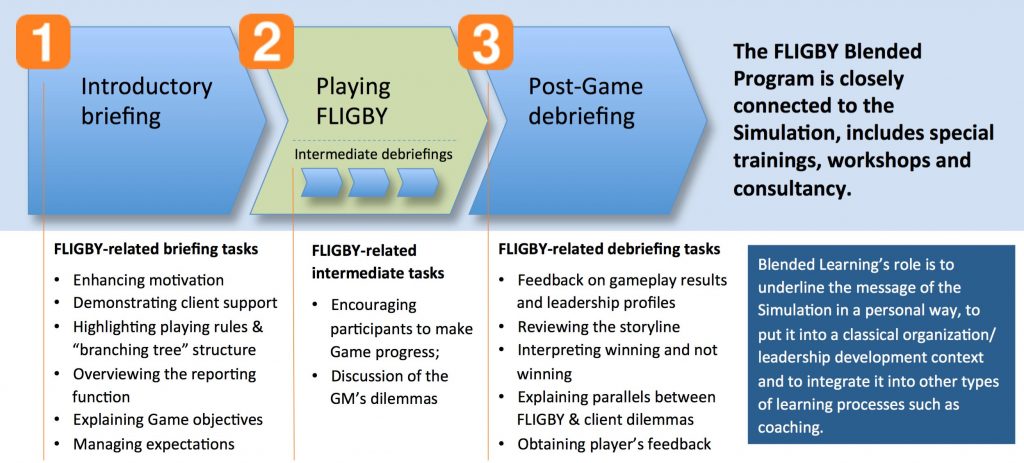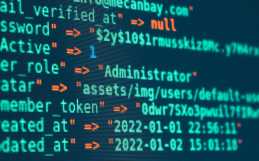Online Leadership Training
Going entirely online with your training
Given the current global health challenges and the changing development needs of globalized organizations, switching to fully online leadership training programs seems inevitable.
This digital transformation is not about changing the roles in the blended-learning setup but the communication channels.
Using online business simulations as part of leadership training programs is a popular way to create an engaging learning experience. Traditional training and game-based simulation are not either/or propositions. In many cases, their benefits can be combined in a well-designed blended-learning approach. Mixing serious games with on-site workshops and face-to-face coaching sessions is an effective form of blended learning. But this is subject to change.
Simulations as a basis for your online leadership training
Online simulations (especially the ones in interactive movie format) tend to be instructor-supported, using qualified people to introduce, facilitate, and debrief the learning process. In this experiential learning model, professional instructors have a high-value role in coaching and diagnosing.
For this reason, top-of-the-class simulations offer an engaging learning journey and sophisticated and structured blended learning support in the form of training, workshop, or different types of coaching. For many years blended learning was an educational approach that combined online interaction with traditional face-to-face, onsite learning methods and required the physical presence of both the participant and the facilitator.
The framework of these approaches looks the same. After a briefing, participants immersed in the simulated virtual environment get feedback and orientation based on their results from their instructors. This means that the participants’ experiences in the simulation, played individually, are discussed in a group. The lessons learned are applied in the context of the organization’s environment and problems during the debriefing workshop.
FLIGBY’s basic blended learning approach:

Since this blended learning setup requires professional facilitating skills, most complex simulation-based leadership programs were conducted (and sold) by training/coaching companies. In the last few years, hosting onsite briefing and debriefing events connected to online simulations has become quite profitable. But given the current global health challenges and the changing development needs of globalized organizations, switching to the fully online version of blended programs is inevitable.
How to blend your online leadership training
This digital transformation is not about changing the roles but the communication channels to enhance simulation-based learning. The software still takes over the job of generating/analyzing the virtual environment, and the instructors still handle the face-to-face pedagogy.
But what does it mean in practice? The traditional, 3 hours long on-site group briefing session and the generally 1-day-long group debriefing sessions are substituted with online meetings via videoconferencing tools (allowing screen sharing).
Accordingly, the fully online FLIGBY blended program looks like the following:
- Opening group video conference (briefing) – On the purpose of the program and simulation, on flow-promoting leadership, and practical guides on simulation-based learning (90 minutes).
- FLIGBY online simulation – Give ten working days to complete the online simulation individually (average gaming time: 5-6 hours, usually in seven chunks).
- Closing group and individual video conference (debriefing) – A 60-minute online debriefing session discussing the major focus points of the simulation, followed by 60-minute individual coaching sessions. The individual coaching sessions (1 session/user, unless requested differently) focus on formulating personal development plans based on individual results.
How to conduct your online sessions in the right way?
If you make content pressing and relevant and your delivery varied and engaging, you can make online learning a success. There are many great articles on the internet around this topic, like this here or here. Based on our own experiences, the followings are a must when you are planning your online briefing or (group) debriefing sessions:
- Have a clear agenda – To make things easy for everyone, prepare a formal agenda with all the key issues to be discussed. Send this agenda at least 24 hours before the meeting and set automated meeting reminders.
- Keep it simple – Cut your planned content in half. You’ll need the extra time for technology snafus, confusion, engagement, and interactions. Batch content in simple, short chunks (less than 5 minutes) and ask questions after each session. Pause frequently to check for understanding, allow for questions, and to breathe.
- Try to involve everybody – Keep track of who has spoken and who hasn’t with a simple paper tally. When you notice the same participants contributing, say, “Let’s hear from some new voices first.”
- Don’t be too serious – Video calls also replace the social interactions that would take place during an on-site program.
- Have technical assistance – Recruit a colleague to handle the technology so that you can focus on content delivery and audience engagement.
- Wear headphones – even if you don’t think you need them.
- Enable video – This is key so that you’re forced to pay attention, and others can pick up on visual clues that would otherwise be lost.
- Use screen sharing – this way, everyone can stay on the same page and follow the instructions you give





